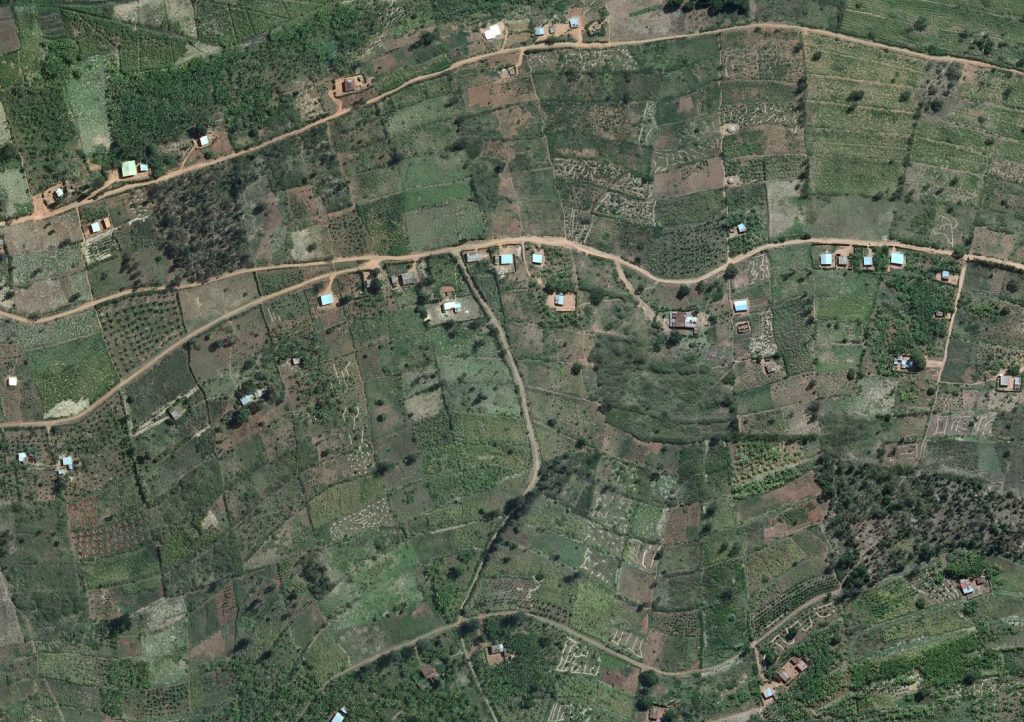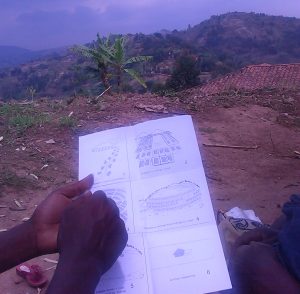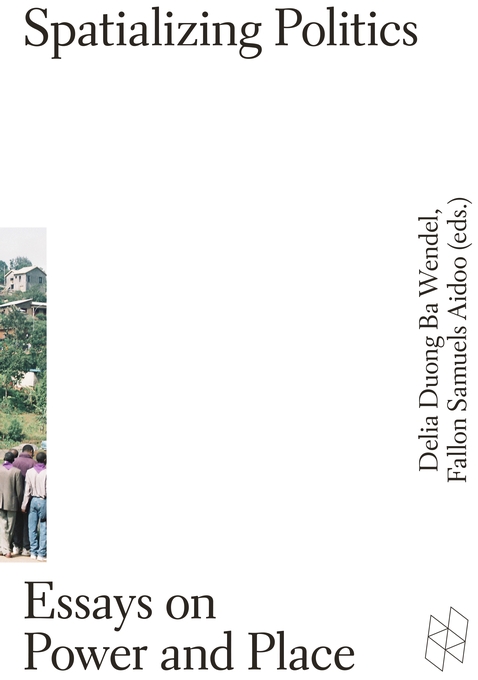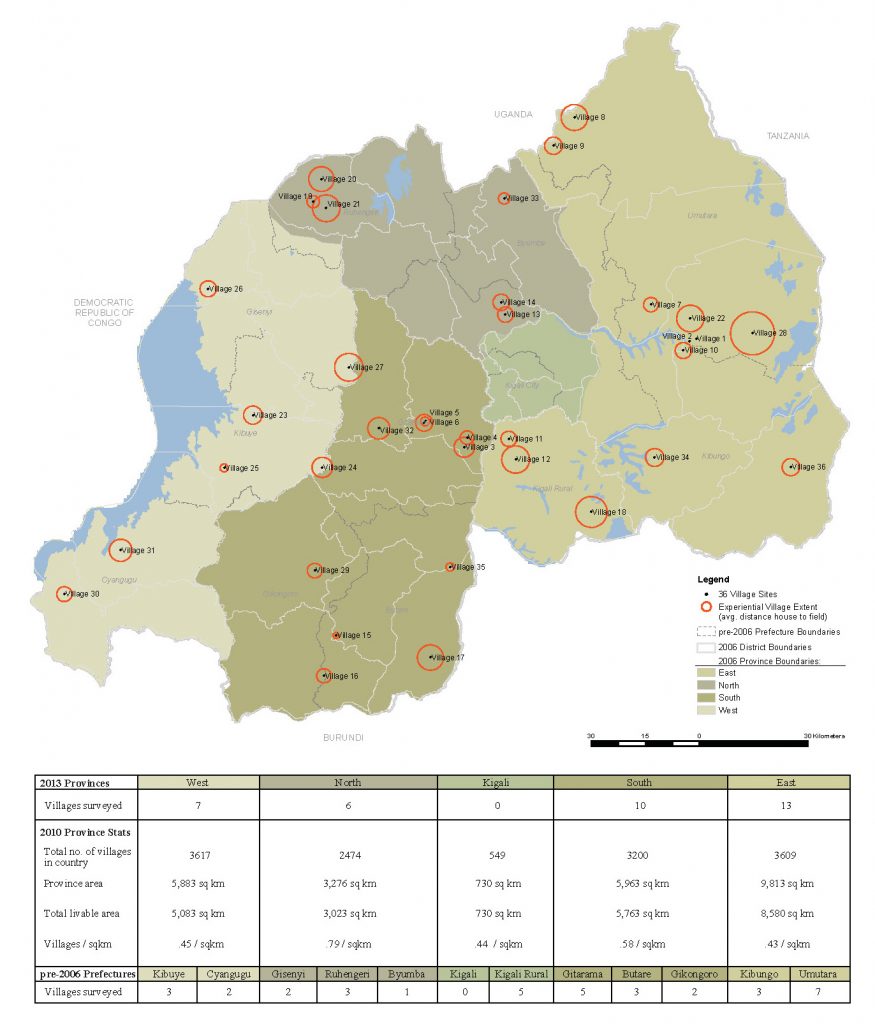In 2013, I asked the same question of every rural resident in Rwanda that I met: “If you were to visit another village, how would you know if peace was there?”1For 21 months during 2011–2013, I conducted research in Rwanda employing a combination of ethnographic, spatial, survey, and historical methods. I asked this question of 614 people in 36 villages. Fieldwork was generously supported by the Social Science Research Council’s International Dissertation Research Fellowship, Harvard’s Sheldon Traveling Fellowship, and Harvard University research grants from the Weatherhead Center for International Affairs, the Harvard Humanitarian Institute, and the David Rockefeller Center for Latin American Studies. I was asking if peace was recognizable—if it was visible or spatial—or perhaps could be experienced. I was asking if peace was more than an ideal. Ultimately, I was inquiring into the everyday conditions and challenges for peace after the 1994 genocide.
A primary school teacher living in a village in northern Rwanda answered my question with a comparison. Christine said:
People can live in villages with houses in rows, places to meet, and good roads, and not have peace. Let me give you an example from Musekeweya. In that radio drama, the characters fight often. But someone who is not from that village would never know that. People in another village could have all of these things and by looking with your eyes you could say that the village is fine. But really, hatred is there.2From the Kinyarwanda:
Abantu bashobora guturana mu midugudu n’amazu aringaniye, ahantu hazwi abantu bahurira, imihanda myiza—bashobora kuba batuye gutyo ariko wenda nta mahoro bafite. Ngiye kuguha urugero muri Musekeweya. Muri icyo ikinamico, urabona ko abantu bakunda gutongana. Ariko umuntu utari uwo muri uwo mudugudu, ntashobora kumenya ngo hari icyo bapfa. Huum, no mu mudugudu rero ibyo bishobora kuba birimo, ukarebesha amaso ngo umudugudu umeze neza. Ariko, inzangano ari zo zirimo.
130805_12-00: 16-17, trans. by D.W.
***
The format of this source indicates a discrete interview that has been anonymized. All interviews are noted by the date (130805) and start time (12-00), followed by the transcript page (16-17) from which a quotation is taken and the initials of the person who translated from Kinyarwanda (D.W.).
Christine drew an analogy between new villages in Rwanda and the fictional villages in a popular local radio drama to reveal disconnects in the ways that peace has been planned and experienced in the country. For Christine, the villages that the government developed after the genocide—where identical houses are equally spaced in grid plans—only offer the appearance of peace in Rwanda. By contrast, her most ready example of prolonged hatred (inzangano) and the prevalence of fighting (gutongana) was located in the world created by a fictional soap opera. It is not that conflicts do not exist between neighbors in Rwanda. Rather, in terms of what is permitted to be spoken, fiction represents reality more freely and accurately.
Christine’s reflections introduce the strategic importance of spatializing social research. On the one hand, this is an issue of research design—one sensitive to opportunities for Christine and others to reveal their views less directly. Such an approach is critical in a country like Rwanda where residents routinely guard their opinions and see penalties for dissent. Throughout the 36 villages that formed the basis of my research, individuals regularly referred to built environments and living conditions as proxies for critical views of neighbors and policies. In these ways, spaces present strategic entry into politicized topics.
“Socio-spatial research responds to the nature of peacebuilding in Rwanda.”On the other hand, socio-spatial research responds to the nature of peacebuilding in Rwanda. After the genocide, the government and its partners employed architecture and planning to do peacebuilding work. Accordingly, a series of spatial projects—including genocide memorials, new rural villages, a roof modernization program, and a radio drama’s fictional communities—form the content of my research on peacebuilding practices in the country. I explore the intentions of these government peace strategies and their impacts on rural residents.3 The radio drama is a nongovernmental project that has independent control over its content, but is sanctioned by the state and runs on the government’s radio station. Both scales—those of national policy and local experience—are critical to defining what and where peace is in Rwanda.
In the following, I describe how I have interpreted socio-spatial research, which may resonate with other scholars who have embraced a “spatial turn” in their disciplines to locate difference, chart the impacts of global forces, and explore the materiality of social life. I also provide a sense of what is at stake in distinguishing between different spatial registers, where assessing actually existing peace is radically different from noting its appearance.
Spatial structures for peace
In the last twenty years, the Rwandan government and international organizations have, through their priorities and projects, progressively indicated that peace is a matter of development. This connection is evident in the country’s villagization program, which was introduced during peace negotiations in 1993 and formalized as state policy in 1996.4 Arusha Peace Accords, 1993: Article 28; Government of Rwanda (GOR), “Policy for Rehabilitation and Social Integration” (Kigali: MINIREISO, June 1996). Government objectives for villagization were twofold: (1) to assure efficient and appropriate land use for the Rwandan population, and (2) to promote national reconciliation and restore peace and unity among the Rwandan people.5 GOR, “Main Orientations of the Policy of Regrouped Settlement Sites in the Rural Areas of Rwanda” (Kigali: Ministry of Internal Affairs, Communal Development and Resettlement, Aug. 1997): p. 4. With these objectives, villagization represents a wider international and paradigmatic turn to development as means to build peace.

Before 1994, most of Rwanda’s rural residents lived in scattered habitats that were located on family farming lands (figure 1). Villages were not common. A severe housing shortage, disputes regarding land ownership, and the mass exodus and return of over 2.7 million people during 1994–1998 accelerated efforts to reform land use, governance, and social relations through villagization. Consequently, the state identified villages as the only legal form of residence and required residents throughout the country to move into newly constructed and grouped settlements (figure 2). Villages house diverse residents, including demobilized soldiers and former perpetrators, genocide survivors, and those returning from long-term exile. Sites provide infrastructure and social services, modernize homes and agricultural production, and order social life. In addition, after 2001, villages have formed the base unit of newly decentralized national governance to promote “a culture of peace, transparency, and participation” at the community scale.6 GOR, Community Development Policy (Kigali: MINALOC, April 2008): p.19.

The strategies deployed by villagization derive from “liberal peace” orthodoxy, which asserts that democratic institutions and a liberal market economy produce stability and peace. Villagization models these goals at the local scale to generate conditions for peaceful coexistence and national development. Critics of liberal peace claim that isomorphic institutional and economic reforms are focused more on nation building than peacebuilding. As a result, programs tend to privilege elite or foreign political and economic interests and poorly address local specificities, underlying causes of conflicts, or the concerns of citizens on the margins. Such a view would see villagization primarily as a development program that focuses on national indicators of progress rather than civil rights and individual challenges to living together after mass violence.
Christine’s above comments ground these critiques in her experience of village life in Rwanda. Furthermore, the confrontation of these government and resident perspectives suggest a need for critical research methods and analytic frameworks that can compare strategies and experiences of peace. The impetus for doing so is the recognition that after mass violence, repair is of paramount importance and something must be done for and with the scores of individuals affected. However, we should be equally cautious about taking peacebuilding strategies as self-evident—and be attentive to the ruptures and conflicts that these projects produce.
Spatial ethnographies of peace
Some of the most cogent critiques of peacebuilding orthodoxy in the last decade have drawn significantly from ethnographic research and case study analyses.7 Séverine Autesserre, The Trouble with the Congo: Local Violence and the Failure of International Peacebuilding (Cambridge: Cambridge University Press, 2010); Stefanie Kappler, Local Agency and Peacebuilding: EU and International Engagement in Bosnia-Herzegovina, Cyprus, and South Africa (New York: Palgrave Macmillan, 2014); Oliver P. Richmond and Jason Franks, Liberal Peace Transitions: Between Statebuilding and Peacebuilding (Edinburgh: Edinburgh University Press, 2009); Michael W. Doyle and Nicholas Sambanis, Making War and Building Peace: United Nations Peace Operations (Princeton: Princeton University Press, 2006). These studies and arguably any research that takes fieldwork as central to its epistemological toolkit have a spatial dilemma: by what criteria and at what scale do we judge research to be adequate for social description? This raises persistent research design questions regarding how outsider-researchers distinguish truth from power and build generalizability from specific locales. These concerns are amplified in contexts where the absence of violence is managed by restrictions on civil liberties, thus opening peacebuilding processes to scrutiny regarding legitimacy, validity, and ethics.
Click to show map of fieldsites
My approach to research was to follow four spatial peacebuilding practices, including villagization, in 36 sites throughout Rwanda. Accordingly, I understand case studies in two senses: as typological—exemplified in the four types of spaces that are employed to build peace—and as physical places of experience. Of the latter: 10 villages are exceptional cases of interventions by either government or nongovernmental groups, and the remaining 26 were randomly chosen from geographically distributed regions to identify diversity and similarity in the cases. To respond to a lack of independent empirical studies on regional differences in these programs, this approach was necessarily exploratory and open-ended in nature. To try to understand the legacies of violence in everyday practices and challenges to peaceful coexistence, my study was guided by ethnographic research. I combined these priorities through multi-sited ethnography.8Representative literature on multi-sited ethnography includes: George Marcus, “Ethnography in/of the World System: The Emergence of Multi-Sited Ethnography,” Annual Review of Anthropology 24 (1995): pp.95-117; Joanne Passaro, The Unequal Homeless: Men on the Streets, Women in their Place (New York: Routledge, 2014); Ananya Roy, “Ethnographic Circulations: Space-Time Relations in the Worlds of Poverty Management,” Environment and Planning A 44, 1 (2012): pp. 31-41.
At each site, my attempt to balance these concerns was to take both people and place as equally relevant analytic categories and sources of knowledge. To do so, my methods included participant observation, life history interviews, geo-located surveys, and spatial analyses gained by in situ mapping, photographic documentation, and diagramming. As a form of socio-spatial research, a “spatial ethnography” such as this expands participant observation by analyzing spatial production, aesthetics, and landscapes of memory as cultural and social practices.9See also research developed by the Spatial Analysis Lab and the Spatial Ethnography Lab.

Spatial ethnographies are attuned to decoding the ways that Rwandan residents narrate complex social and political views through spatial metaphors and descriptions of living conditions. Kinyarwanda colloquialisms such as ku giti cyanjye, yari mu Mbyo, and ndi ku gasozi exemplify everyday uses of spatial figures in Rwanda. Ku giti cyanjye signals the start of an individual’s opinion but literally translates as “on my tree.” Yari mu Mbyo translates as “he was in Mbyo,” but here Mbyo is both a specific place in Rwanda and a toponym for wilderness, such that if he were in Mbyo he was nowhere, or in the bush and alone. Similarly, ndi ku gasozi translates as “I am on the small hill” but connotes emplacement in unfavorable situations such as poverty, despair, or misfortune. These are widely used idioms that employ figurative spaces (igiti/tree, Mbyo/wild place, and agasozi/small hill) as referents for subjectivity.

Alphonse, a young man who lives in the same village as Christine, illustrated this further in conversation. He lives in a house two rows back from the village’s new access road. Most houses are of the same, uniform design: rectangular 18-by-24-foot structures constructed from mud bricks and covered with metal shed roofs, located within a larger, quasi-private area designated for domestic work (urugo). On fields adjacent to homes, the dark soil characteristic of this region is periodically tilled and piled high over rows of potato plants. Stacks of rough, porous rocks trace the edges of house and farming plots. These volcanic rocks are plentiful here near the Virunga Mountains and are widely used as boundary, regional identity, and social status markers. The crops and houses are all new; this flat and wide hilltop was cleared of its trees, measured and parceled by local government authorities, and resettled by area residents between 2010 and 2012. When I asked how residents received assistance to build and move to his village, Alphonse responded:
The government supported everyone without singling them out. Yes, and it said, “there, those houses are destroyed—they suffered,” so they helped them. If your house wasn’t destroyed, you cannot ask them to help you. Also, with your friend, whom they helped: you cannot be jealous of him because he faced actual problems.10 From the Kinyarwanda:
Ni ukuvuga ngo leta yabafashije nta kureba ku butoni. Nta kurobanura. Yee, ngo ivuge ngo “uriya ni iki, yabonye yuko basenyewe, bakorewe ibiki byose,” irabafasha. Ntago waba wowe utarasenyewe, ngo maze ngo uvuge ngo bagufashe. Kandi noneho uwo bafashije mugenzi wawe ntugomba kumugirira ishyari yuko bamufashije. Kandi yarahuye n’ikibazo nyine.
130805_13-16: 44-45, trans. by D.W.
Rather than refer to ethnic identity, which is excluded from public discourse in Rwanda, Alphonse narrates social identity through house damages during the genocide. Those whose houses were destroyed, implicitly Tutsi genocide survivors, are recognized by the government for reconstruction assistance. Alphonse and other interviewees regularly claimed that all citizens received equal opportunity for this aid. However, a strong caveat was also often repeated, as above, regarding what was considered a permissible social expectation. It is understood that those whose houses were not targeted by the genocide, implicitly the majority Hutu population, cannot ask the government for help nor express discontent because they do not face “actual problems.” Alphonse’s reflections illustrate the epistemological value of spatial ethnography. More critically, he provides a sense of how villagization—a developmentalist approach to peacebuilding—reorders social life after the genocide.
“Villagization has had real impacts on forms of social cohesion and trust.”Tracing the social and spatial process of villagization across multiple sites builds a composite understanding of peace in Rwanda. Throughout the country, residents typically claimed that new villages structure neighborliness. They draw from quotidian examples, where individuals share water and land, tend kitchen fires for neighbors and watch others’ children, and greet each other on paths between homes. In these ways, villagization has had real impacts on forms of social cohesion and trust.11 These views contrast to reactions in the 1990s and early 2000s, where researchers documented issues related to forced relocation, differential treatment of beneficiaries, absenteeism in new houses, and poor construction. Many of these issues persist today alongside claims that villages structure neighborliness. However, and quite critically, residents who do not fully agree with this view are usually very poor or socially stigmatized. The latter comes as a consequence of “outsiderness,” ethnic identity, familial relationships to genocide perpetrators, or as a result of being accused or convicted of genocide crimes. For many, villages are not more secure: relocating requires land exchanges that make livelihoods more precarious and brings residents closer to neighbors that regard them with suspicion. Villages reproduce existing tensions and create a more intense environment for reconciliation. Peace maps unevenly onto class inequality and social identity.
In this work, attending to both symbolic and phenomenological spaces exposes contradictions in how peace is built and experienced. This is situated knowledge that identifies the contingent and contextual aspects of claims, power, and identity.12 This is a point that I expand further in “Toward a Spatial Epistemology of Politics,” in Spatializing Politics: Essays on Power and Place, ed. by Delia Duong Ba Wendel and Fallon Samuels Aidoo.
 Cambridge: Harvard GSD/University Press, 2015.More info → Planning for complexity, designing for the margins, learning from local views, and addressing the structural and underlying causes of conflict—these are just some of the urgent issues that could advance equity in peace and development processes. Spatializing social research can reveal difference with a view to locating opportunities for greater inclusion.
Cambridge: Harvard GSD/University Press, 2015.More info → Planning for complexity, designing for the margins, learning from local views, and addressing the structural and underlying causes of conflict—these are just some of the urgent issues that could advance equity in peace and development processes. Spatializing social research can reveal difference with a view to locating opportunities for greater inclusion.
References:
Abantu bashobora guturana mu midugudu n’amazu aringaniye, ahantu hazwi abantu bahurira, imihanda myiza—bashobora kuba batuye gutyo ariko wenda nta mahoro bafite. Ngiye kuguha urugero muri Musekeweya. Muri icyo ikinamico, urabona ko abantu bakunda gutongana. Ariko umuntu utari uwo muri uwo mudugudu, ntashobora kumenya ngo hari icyo bapfa. Huum, no mu mudugudu rero ibyo bishobora kuba birimo, ukarebesha amaso ngo umudugudu umeze neza. Ariko, inzangano ari zo zirimo.
130805_12-00: 16-17, trans. by D.W.
***
The format of this source indicates a discrete interview that has been anonymized. All interviews are noted by the date (130805) and start time (12-00), followed by the transcript page (16-17) from which a quotation is taken and the initials of the person who translated from Kinyarwanda (D.W.).
Ni ukuvuga ngo leta yabafashije nta kureba ku butoni. Nta kurobanura. Yee, ngo ivuge ngo “uriya ni iki, yabonye yuko basenyewe, bakorewe ibiki byose,” irabafasha. Ntago waba wowe utarasenyewe, ngo maze ngo uvuge ngo bagufashe. Kandi noneho uwo bafashije mugenzi wawe ntugomba kumugirira ishyari yuko bamufashije. Kandi yarahuye n’ikibazo nyine.
130805_13-16: 44-45, trans. by D.W.
 Cambridge: Harvard GSD/University Press, 2015.More info →
Cambridge: Harvard GSD/University Press, 2015.More info →













